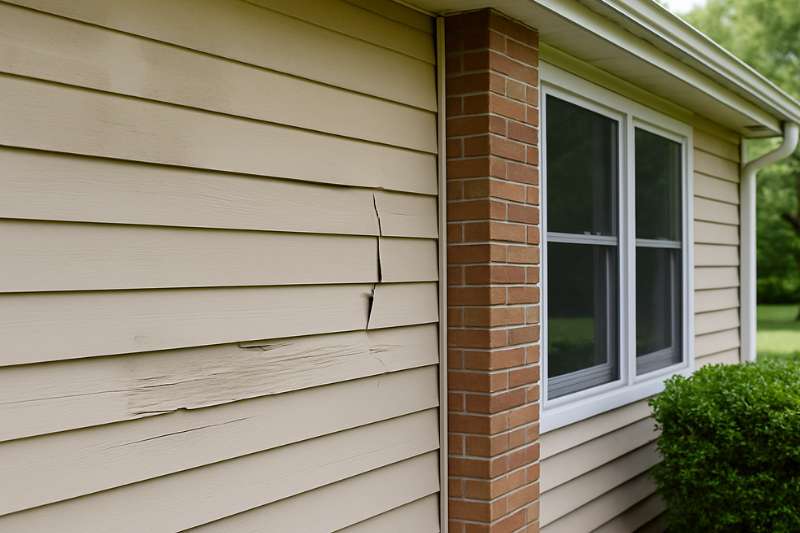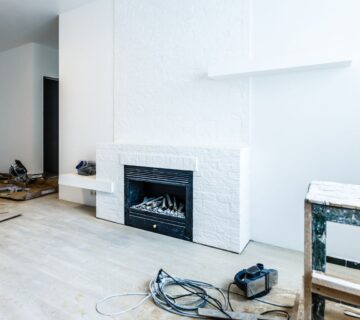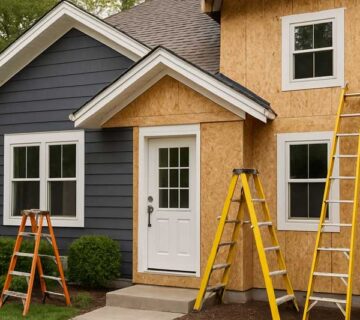Your home’s siding is its first line of defense against weather and time. But how do you know when to replace siding? Old or damaged siding can lead to moisture problems, higher energy bills, and a worn-out appearance. In this post, we’ll walk you through the top warning signs that it’s time for a siding upgrade.
Why Siding Replacement Is Important
Siding plays a critical role in your home’s curb appeal, insulation, and structural protection. Damaged or outdated siding can result in water infiltration, pest issues, and increased utility bills. Replacing siding at the right time prevents costly repairs, enhances energy efficiency, and improves your home’s overall value and appearance.
Visible Damage and Wear
Cracks, Warping, or Holes
If your siding shows signs of cracking, warping, or small holes, it’s a clear indication that it’s deteriorating. These issues allow moisture and pests to enter the walls, leading to bigger structural problems. Cracked siding not only looks bad—it can compromise your home’s long-term safety and comfort.
Loose or Missing Panels
Strong winds, age, or poor installation can cause siding panels to come loose or fall off. Missing pieces expose your home’s underlayment to rain and UV damage. If you notice panels shifting or gaps forming, it’s likely time to consider replacing your siding before further deterioration occurs.
Moisture Problems and Interior Signs
Mold, Mildew, or Water Stains Inside
Siding should keep water out. If you see mold, mildew, or brown water stains on your interior walls, your siding may be failing. These signs indicate that moisture is leaking through the siding and damaging your home’s internal structure. The longer you wait, the worse it can get.
Peeling Paint or Wallpaper
Paint or wallpaper that bubbles or peels without another cause could be reacting to trapped moisture inside the walls. Damaged siding often allows rain or humidity to seep through, resulting in hidden water damage. Replacing your siding can eliminate the root cause and protect your interior finishes.
Rising Energy Bills
Poor Insulation Performance
When siding starts breaking down, your home becomes less insulated. You might notice that rooms feel drafty or your HVAC system works harder. If your energy bills are rising without another clear reason, your siding could be letting air escape or enter freely—costing you comfort and money.
Outdated Siding Materials
Older siding materials may not meet today’s energy-efficiency standards. Vinyl siding installed decades ago may lack proper insulation backing. By upgrading to insulated siding, you can reduce heat transfer, improve comfort, and lower monthly energy expenses while modernizing the look of your home.
Fading and Discoloration
UV Damage Over Time
Sun exposure causes siding to fade, especially on south-facing walls. If your siding’s color looks washed out or uneven, it may no longer protect effectively against heat or moisture. Severe fading often indicates your siding has aged beyond its prime and isn’t performing as it should.
Appearance Looks Tired or Dated
Even if your siding still functions, it might make your home look outdated. Worn, faded, or discolored siding reduces curb appeal and resale value. Modern siding options come in bold colors and finishes that can give your home a fresh, contemporary look while offering better protection.
Recurring Maintenance and Repairs
Frequent Caulking or Painting
If you find yourself repainting or re-caulking your siding every few years, it’s time to consider an upgrade. Quality siding should hold paint for at least 8–10 years. Constant maintenance signals that your siding is breaking down and no longer adhering well to finishes or weatherproofing.
Ongoing Repairs Add Up
Minor repairs like patching cracks or replacing single panels might work short-term. But if the issues are frequent or affecting multiple areas, full replacement becomes more cost-effective. Instead of pouring money into temporary fixes, investing in new siding offers long-term protection and peace of mind.
Conclusion
Knowing when to replace siding can save you from expensive repairs and energy loss. If you’re seeing damage, moisture signs, or higher energy costs, it’s time to act. New siding not only protects your home—it can completely transform its look and boost its value.
✅ Need a siding inspection? Contact Lopez Chavarria Construction today to schedule your free estimate and get expert advice on replacing your home’s siding.






No comment